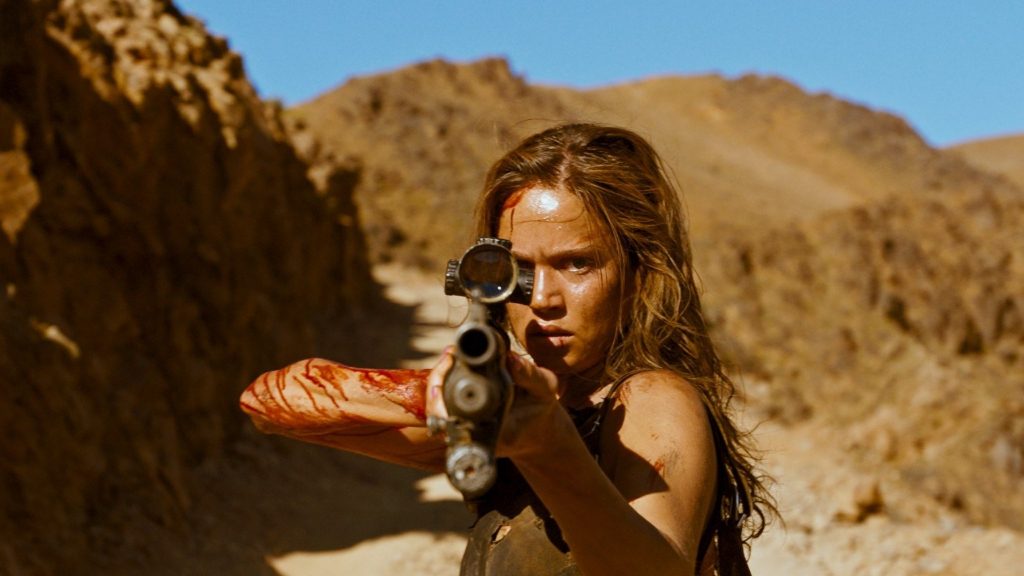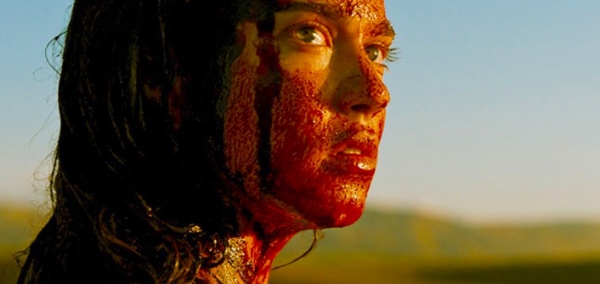READ ME is a platform for female-led writing on film hosted by Girls on Tops. Louisa Maycock (@louisamaycock) is Commissioning Editor and Ella Kemp (@efekemp) is Contributing Editor.
For Halloween and beyond, Katie Goh asks why women love the genre that so often tears them apart.
When Jason Blum, the horror mastermind of Blumhouse Productions, was asked in an interview with Polygon, why Blumhouse hasn’t had a theatrical release directed by a woman, he answered: “[t]here are not a lot of female directors period, and even less who are inclined to do horror.” The internet caught on proverbial fire. Blum tweeted an apology. While his answer was, as he himself described, a “dumb comment,” it speaks to the larger cultural stereotype that horror is a man’s genre. This, however, couldn’t be further from the truth.
Research by Google found that horror is the only genre in which women are seen on screen more than men, surpassing rom-coms. It’s also the only genre in which women have the most speaking time on screen. A direct correlation between representation on screen and box office can be found, as horror films are consistently evenly split between male and female audiences.
Is it any wonder women turn out for horror? At its origins in literature, the genre has always been rooted in female experience, with Mary Shelley birthing the first body-horror sci-fi novel in 1818 and Ann Radcliffe being the most popular gothic writer of the nineteenth century. In these precursors to modern horror, women’s fears take centre stage. Shelley’s Frankenstein is concerned with what will happen when women are no longer needed to reproduce, while Radcliffe’s Italian Gothics are about young female protagonists’ sexual coming of age.
If women are the mothers of the horror genre, the reputation of horror movies as male-dominated narratives points to an appropriation of the form by men. In the mid-twentieth century touchstones of the genre, I Spit on Your Grave (1978), The Last House on the Left (1972), Halloween (1978), Psycho (1960), Carrie (1976), and Friday the 13th (1980), the narratives may still be about women but they’re under the control of male directors. Young women are sexualised, terrorised, stalked, stabbed, mutilated, raped, penetrated by villains and the camera. Their promiscuity is punished and their femininity is always their downfall. There’s a reason why Carrie becomes a man-killing telekinetic monster when she begins to menstruate. It’s no surprise then, that the horror genre has been widely accused of misogyny. In 1982, Janet Maslin compared horror movies to “hardcore sexual pornography” in the New York Times, arguing that “these films exploit and brutalize women.”
So why, when growing up, did I and so many other women love these horrifying movies accused of hating women? While it’s true that horror’s heroines are punished for their sexuality, these were the only movies about female sexuality, full-stop. Viewed as metaphorical rather than literal, Carrie depicts a bullied and abused teenager realising the power of womanhood and how much society wants to crush that power. I Spit on Your Grave is a brutal rape-revenge B-movie about men punishing a woman who chooses independence. That’s not to excuse these films’ misogyny or push a counter-argument that they’re feminist. They’re not. But watching I Spit on Your Grave and Carrie as a teenage girl, it was the first time seeing the misogyny I was beginning to experience in real life played out on screen. There’s a twisted catharsis in watching a teenage girl being assaulted and chased by a masked man, if you’re also a teenage girl. There’s validation that comes from seeing your fears realized on screen. When the female protagonist outwits your assailant, fights back, or has her revenge, the catharsis is liberating. If the girl in the movie can survive society’s intentions to punish her, maybe I can too.
The films referenced so far were directed, and mostly written, by men. While women were making horror movies in the twentieth century – for example, Amy Holden Jones’ The Slumber Party Massacre (1982) and its sequels which were the first horror series in history directed exclusively by women, Kathryn Bigelow’s vampire horror Near Dark (1987), Ida Lupino’s noir-thriller The Hitchhiker (1953) – until more recently, the genre was largely the realm of men.
In the last five years, female-directed and female-centric horror has moved from the genre’s margins and into the spotlight. Julia Ducournau’s Raw (2016) follows Justine, a strict vegetarian who goes to veterinary school and during a hazing ritual is forced to eat meat. She soon develops a taste for raw flesh that escalates. Raw is a feast of female body-horror; sex, eating disorders and alienation dissected on Ducournau’s operating table.
In rape-revenge horror, perhaps the subgenre most accused of misogyny, Coralie Fargeat’s Revenge takes films like I Spit on Your Grave and The Last House on the Left and tears them apart with her teeth. The film opens like any rape-revenge story: a beautiful young woman, as objectified by the camera as she is by the men around her, is raped and left for dead, before arising from her grave to seek revenge. While Revenge’s narrative is in keeping with the genre, Fargeat’s careful direction subverts its expectations. Instead of an uncontrollable monster, our hero is an action woman, and rather than torture porn, Fargeat chooses not to show the assault on screen. It’s a nasty, grisly fantasy which reimagines the genre from a survivor’s perspective. What was the last horror movie you watched that ended with a woman covered in blood that’s not her own?
In the realm of psychological horror is The Babadook (2014), Jennifer Kent’s film that dissects the paranoia and alienation of single motherhood through the tropes of fairytales. Alice Lowe’s Prevenge (2017) similarly explores the body horror of pregnancy. After the death of her partner, Ruth finds herself pregnant and begins to hear voices coming from her womb. Something is taking over her and urging her to kill. At one point a midwife tells Ruth, “You have absolutely no control over your mind or body now. Baby will tell you what to do.” Society loves telling women what they can and can’t do with their bodies, especially their wombs.
Over the last five years, there’s been a wealth of female-centric original horror that has rescued the genre from a run of remakes and sequels. While female experience has always been at the forefront of horror movies, with women at the helm, feminine anxieties are being portrayed from the women’s perspectives rather than the men’s. Watching Raw, Revenge, The Babadook, and Prevenge, it’s increasingly clear why so many women love the genre, why we can’t stop using horror to play out our fears, and why we can’t look away. Long may we gorge on it.
Katie Goh (@johnnys_panic) is a freelance arts writer and editor based in Edinburgh. Her words have popped up in The Guardian, Sight and Sound, Dazed, The Independent, The Skinny, Huck, and more.



